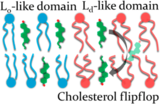MARTINI Force Field
A coarse-grain (CG) force field suited for molecular dynamics simulations of biomolecular systems.
The MARTINI force field, developed between the groups of Marrink and Tieleman, is a coarse grained force field suited for molecular dynamics simulations of biomolecular systems. The force field has been parametrized in a systematic way, based on the reproduction of partitioning free energies between polar and apolar phases of a large number of chemical compounds.
The model uses a four-to-one mapping where, on average, four heavy atoms are represented by a single interaction center. In order to keep the model simple, only four main types of interaction sites are defined: polar (P), non-polar (N), apolar (C), and charged (Q). Each particle type has a number of subtypes, which allow for an accurate representation of the chemical nature of the underlying atomistic structure.
Something else about MARTINI
Currently, topologies are available for many lipids and surfactant molecules, including cholesterol, and for all amino acids as well as for sugars and polymers. Scripts are furthermore available to build topologies for arbitrary peptides and proteins, to add elastic networks, and to move between coarse-grained and atomistic representations.
Related publications

Announcing the open beta version of MARTINI 3!
New parameters of the MARTINI force field in the open beta release. Ready to perform CG simulations of phospholipid bilayers and proteins.

